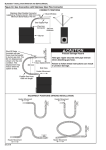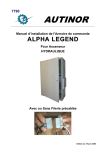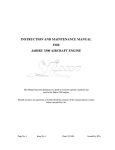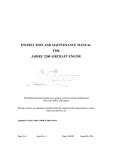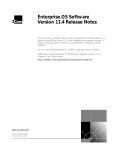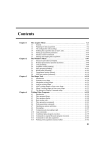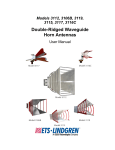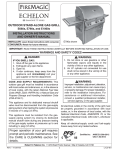Download p522 application manual.p65
Transcript
FLAME MONITORING SYSTEM MODEL P522 SIGNAL PROCESSOR APPLICATION MANUAL IRIS MODEL P522 APPLICATION MANUAL Table of Contents IRIS MODEL P522 --------------------------------------- 4 WIRING AND INSTALLATION------------------------ 4 FIGURE 1 - P522 REAR MOTHERBOARD ------- 4 WIRING TO THE PLUG-IN TERMINALS ---------- 5 WIRING OF VIEWING HEAD ------------------------- 6 FIGURE 2 - WIRING OF VIEWING HEAD -------- 6 FIGURE 3 - WIRING AND ASSEMBLY VIEWING HEAD -------------------------------------- 7 OPTIONAL LTA ADAPTER ---------------------------- 7 POWER SUPPLY ---------------------------------------- 8 FIGURE 4 - POWER SUPPLY TABLE ------------- 9 FACTORY STOCKED POWER SUPPLIES ------- 9 REDUNDANT POWER SUPPLIES ------------------ 9 SELF-CHECKING FUNCTION --------------------- 10 APPROVALS -------------------------------------------- 10 POWERING UP THE P522 -------------------------- 10 SET POINTS -------------------------------------------- 11 FIGURE 5 - SET POINTS ---------------------------- 11 CHANGING SET POINTS --------------------------- 11 FLAME FAILURE RESPONSE TIME (F.F.R.T.) 12 4-20mA REMOTE OUTPUT ------------------------- 12 FIGURE 6 - REMOTE METER ANALOG OUTPUT 12 INSTALLATION OF VIEWING HEAD ------------- 13 FIGURE 7 - VEWING HEAD CROSSREFERENCE TABLE --------------------------- 13 SIGHTING OF THE VIEWING HEAD ------------- 13 MULTIBURNER REQUIREMENTS --------------- 14 FIGURE 8 - CUTOFF FREQUENCIES ----------- 14 MULTIPLE VIEWING HEADS ---------------------- 14 DETERMINING SIGHT PIPE SIZE ---------------- 15 SELECTING THE PIPE ------------------------------- 15 MOUNTING HOLE ------------------------------------- 15 MOUNTING OF SIGHT PIPE ----------------------- 15 INSTALLING THE VIEWING HEAD --------------- 15 PURGE AIR ---------------------------------------------- 15 SETUP AND ADJUSTMENT PROCEDURES -- 16 SIGHTING ADJUSTMENT --------------------------- 16 INITIAL SETUP ----------------------------------------- 16 ADJUSTING SET POINTS -------------------------- 17 TROUBLESHOOTING GUIDE --------------------- 18 NOISE INTERFERENCE AND GROUNDING -- 18 Page 2 S506 VIEWING HEAD -------------------------------- 19 S506 SELF-CHECKING VIEWING HEAD ------- 20 S509 VIEWING HEAD -------------------------------- 20 S511 VIEWING HEAD -------------------------------- 21 S512 VIEWING HEAD -------------------------------- 21 ORIFICING ----------------------------------------------- 23 FIGURE 9 - ORIFICING: SIGNAL-REDUCING CHARACTERISTICS OF DISCS ---------------- 23 SIGNAL SOURCES ----------------------------------- 23 VIEWING HEAD - ANGLE OF VIEW ------------- 24 FIGURE 10 - VIEWING HEAD: ANGLE OF VIEW - DISTANCE AND DIAMETER ------------------- 25 APPLICATION OF IRIS VIEWING HEADS ----- 25 LOW NOx APPLICATIONS -------------------------- 26 APPLICATION OF P522 ----------------------------- 26 USING A PLC WITH IRIS FLAME MONITOR -- 26 FIGURE 11 - VIEWING HEAD APPLICATION TABLES ------------------------------------------------ 27 FIGURE 11 - VIEWING HEAD APPLICATION TABLES Cont’d --------------------------------------- 28 BASIC BURNER START CIRCUIT ---------------- 29 FIGURE 12 - BASIC BURNER START CIRCUIT 30 MODULE COMMUNICATIONS -------------------- 31 MODBUS COMMUNICATION ---------------------- 31 COMMUNICATING WITH MODICON PLC ----- 32 COMMUNICATION WITH HUMAN-INTERFACE HOST COMPUTER --------------------------------- 32 RS-232 to RS-422 CONVERSION----------------- 32 SETTING ADDRESSES ------------------------------ 32 TECHNICAL HELP------------------------------------- 33 FIGURE 13 - SPECIFICATIONS ------------------- 34 FIGURE 14 - MODEL P522 FRONT PANEL --- 35 FIGURE 15 - MODEL P522 SIDE VIEW --------- 36 FIGURE 16 - S5XX VIEWING HEAD DIMENSIONS ------------------------------------------- 36 FIGURE 17 - IR VIEWING HEAD LOCATION-- 37 FIGURE 18 - UV VIEWING HEAD LOCATION 37 FIGURE 19 - OPPOSED FIRED VIEWING HEAD SIGHTING -------------------------------------- 38 FIGURE 20 - VIEWING HEAD MOUNTING ---- 38 INDEX ----------------------------------------------------- 39 IRIS MODEL P522 APPLICATION MANUAL Figure Index FIGURE 1 - P522 REAR MOTHERBOARD -------------------------------------------------------------------- 4 FIGURE 2 - WIRING OF VIEWING HEAD --------------------------------------------------------------------- 6 FIGURE 3 - WIRING AND ASSEMBLY - VIEWING HEAD ------------------------------------------------ 7 FIGURE 4 - POWER SUPPLY TABLE -------------------------------------------------------------------------- 9 FIGURE 5 - SET POINTS ----------------------------------------------------------------------------------------- 11 FIGURE 6 - REMOTE METER ANALOG OUTPUT -------------------------------------------------------- 12 FIGURE 7 - VEWING HEAD CROSS-REFERENCE TABLE -------------------------------------------- 13 FIGURE 8 - CUTOFF FREQUENCIES ------------------------------------------------------------------------ 14 FIGURE 9 - ORIFICING: SIGNAL-REDUCING CHARACTERISTICS OF DISCS ----------------- 23 FIGURE 10 - VIEWING HEAD: ANGLE OF VIEW - DISTANCE AND DIAMETER ---------------- 25 FIGURE 11 - VIEWING HEAD APPLICATION TABLES -------------------------------------------------- 27 FIGURE 11 - VIEWING HEAD APPLICATION TABLES Cont’d ---------------------------------------- 28 FIGURE 12 - BASIC BURNER START CIRCUIT ----------------------------------------------------------- 30 FIGURE 13 - SPECIFICATIONS -------------------------------------------------------------------------------- 34 FIGURE 14 - MODEL P522 FRONT PANEL ---------------------------------------------------------------- 35 FIGURE 15 - MODEL P522 SIDE VIEW ---------------------------------------------------------------------- 36 FIGURE 16 - S5XX VIEWING HEAD DIMENSIONS ------------------------------------------------------ 36 FIGURE 17 - IR VIEWING HEAD LOCATION--------------------------------------------------------------- 37 FIGURE 18 - UV VIEWING HEAD LOCATION ------------------------------------------------------------- 37 FIGURE 19 - OPPOSED FIRED VIEWING HEAD SIGHTING ------------------------------------------ 38 FIGURE 20 - VIEWING HEAD MOUNTING ----------------------------------------------------------------- 38 Page 3 IRIS MODEL P522 APPLICATION MANUAL RF C RF O N RF O N RF C SC C GN D +26V BAT RF O FF Before wiring or installing the P522, we recommend that you read the companion colour brochure describing the functions and attributes of this series of signal processors. RF O FF The P520 and P522 Signal Processors are used with the IRIS Model 500 Viewing Heads. The P522 Signal Processor is a relay panel mount version of the P520 plug-in module, and replaces the M502 motherboard and its two plug-in daughter boards, the A513 and the D504. SC O N WIRING AND INSTALLATION SC O FF IRIS MODEL P522 SC RELAY F1 .75A RF RELAY +26V SIG G ND SIG 0-20mA or 4-20mA ANALO G CURRE NT DRIV E F2 .25A VH SEL RELAY SHUTTER DRIV E CHAN SELECT V.H .A. FIGURE 1 - P522 REAR MOTHERBOARD Page 4 +V V.H .B. G ND V.H . SEL SC + SIG G ND SIG RM T CHAN M ETE R SEL - G ND + +V - SC + SIG G ND SIG G ND -RX -TX +R X +TX RS-422 IRIS MODEL P522 APPLICATION MANUAL WIRING TO THE PLUG-IN TERMINALS and is rated at .25 Amp. On newer units (those with Figure 1 illustrates the plug-in terminals on the rear mother board and how they are connected internally. The flame relay and self-checking relay contacts are situated together in the upper right portion of the diagram. NO, CAL, and YES in red letters on the front panel) these fuses are self-resetting types, and will recover from an overload automatically after power is removed from the P522 for 10 seconds. The viewing head terminals (bottom right) are identified as V.H. A. and V.H. B. If only one viewing head is used, you must wire to the V.H. A. terminals. To the left of the viewing head terminals are two terminals marked V.H. SEL (viewing head seSC C refers to the common terminal of the self-check- lector relay). Energizing this connection with 19 to ing relay. There is only one pair of contacts used 38 VDC will cause the relay on this PC board to for the self-checking function. Here, the designa- switch to viewing head B. The nominal voltage of tion ON refers to the self-checking taking place in a this relay is 24V, but the 26 VDC power circuit can normal manner. OFF indicates a failure in the view- be used to switch this relay, if desired. ing head or processor resulting from: Only the viewing head signal wire (SIG) and the sig- the hardware (i.e. the shutter mechanism in nal ground wire (SIG GND) are switched with this the viewing head, or the output relay itself); changeover relay; the 26 VDC and power ground circuit is not disturbed. Make sure that the viewing - electronic components anywhere, or head signal wire and signal ground (braided shield internal software in the P522; or in the four-conductor cable) are both connected, because this ground connection is the only return path - the power to the unit is OFF – the most for the signal and self-checking circuit. Also, the 26 likely condition. VDC used to switch this relay must be connected The main power feeds in through the terminals situ- with the proper polarity, because the relay used is a ated on the upper left side (see GND, +26V and BAT). single-side stable type. (Relays that are polarized Each designated terminal is a double terminal, or pair, magnetically offer increased contact force resulting so that the wiring from the power supply can be “daisy in higher current-carrying capability). The two terchained” from one P522 to the next without having to minals marked V.H. SEL go directly to the relay coil. twist wires together into one termination. The pair of terminals designated CHAN SEL (to the The pair designated BAT is for battery backup, if left of the V.H. SEL terminals) is used for selecting used. Note the rectifier used internally to prevent channel A or channel B on the P522. Energizing the 26 VDC main power supply from feeding into this pair of terminals causes the B channel to be sethe battery. The backup battery, if used, should be lected. Polarity must be observed when wiring this 24 volts, to ensure that the 26 VDC power feeding connection (the positive terminal is on the right). the P522 will not feed back into the battery. In other This is an isolated input, so two wires are required. words, no current will flow from the battery as long Any DC voltage from 7.5 to 30 may be used. The as voltage of the main power supply is above that of current required will depend upon the voltage, bethe battery. The negative side of the battery goes to cause this is a photocoupler interface circuit with a the GND terminal on the left. 3900 ohm resistor feeding the LED light source. RF C refers to the common terminal of the flame relay, with ON being flame on, and OFF being flame off. You will note that there are two sets of contacts used for the flame relay. Figure 1 shows how these terminals are connected For example: a 26 VDC voltage will result inside the P522. Note the two fuses marked F1 and in a current flow of 25/3900 = .0064 Amp. F2. F1 is the main power fuse for the signal processor as well as the viewing head(s), and is rated at .75 If flame is being detected and the channels are Amp. Fuse F2 feeds only to the viewing head(s), switched, the flame relay will remain energized for Page 5 IRIS MODEL P522 APPLICATION MANUAL one cycle regardless of the new set points, allowing channel changes “on the fly,” so to speak. If the new flame OFF set point is equal to or greater than the current signal count, then the flame relay will de-energize on the subsequent cycle. be used to communicate with the P522, and the connections are made to the terminals marked +TX, TX, +RX and -RX. The transmitting, twisted pair goes to the TX terminals, and the receiving, twisted pair goes to the RX terminals. The pair of terminals designated RMT METER (to the left of the CHAN SEL terminals) is for the remote meter connection. This output is a current-driven signal that ranges from 0 to 20 mA for remote meters, and can be switched to a range of 4 to 20 mA for DCS (distributed control system) applications (refer to section 4-20mA REMOTE OUTPUT). Connect the terminal marked “positive” to the positive meter terminal. This current signal can be used with a volt meter by feeding the signal to a resistor connected to the ground. The voltage developed across the resistor will follow Ohm’s law V = IR. Note: the terms “transmit” and “receive” used here with respect to the P522 will be reversed with respect to the RS-232 connection on the host computer. Refer to later sections in this manual for a detailed description of the software and how it is to be used with the P522. For example: a 3-volt meter can be used with a resistor of 3/.02 = 150 ohms, which will result in a full-scale reading of 3 volts for a 20mA output. The four terminals called +TX, -TX, +RX, and -RX (to the left of RMT METER terminals) are used for the serial communication link. The serial communication is achieved by using ASCII character code transmission at 4800 or 9600 baud through the RS232 com ports on the host computer. The P522 uses RS-422 data transmission which is over two, twisted pairs that are differentially transmitted and received, allowing long wire runs to be used through noisy environments. An RS-232 to RS-422 converter must WIRING OF VIEWING HEAD Wiring of the viewing head is made to the terminals on the lower right side of the P522. These terminals are described as follows: TERM DESCRIPTION +V 24 VDC power to viewing head GND Power Ground SC Self-check/shutter drive signal to viewing head SIG Flame signal from viewing head SIG GND Signal ground Figure 2 shows a four-conductor cable to the viewing head. Note that the flame signal wire going to terminal SIG is shielded, and the shield is terminated at both ends of the cable SIG GND. P522 RED W IRING SIDE VIEW - CO VER REM OV ED G R EE N B LA CK +V GND SC SIG GND +24VDC GND SH UT TER D RIV E GND W H ITE CO NNE CT SHIELD TO TERM 3 USE S HRINK TUBING Page 6 SH IELD FIGURE 2 - WIRING OF VIEWING HEAD SIG SIGN AL IRIS MODEL P522 APPLICATION MANUAL IRIS CABLE 3 COND UCTO RS PLUS 1 COA X 3CO NDUCTORS: 16 AW G 19 STRAND INSULATED WITH CRO SSED-LINKED-POLYETHYLENE .017 THK CO LOR S: BLA CK-RED-GREEN 1 COAX: 16 AW G 19 STRAND INSULATED WITH CRO SSED-LINKED-POLYETHYLENE .017 THK CO LOR WH ITE 36 AW G BRAIDED SH IELD 90% CO VERA GE W ITH .012 THK JACK ET C OLO R BLACK CABLED: POLYPROPYLENE FILLER S FO R ROUNDNESS JACK ET: CROSSED-LINKED-POLYETHYLENE GR OM MET FLAT WASHER STRIP 3/8“ TYPIC AL CABLE ENTRY NUT CABLE CABLE PREPA RATION CABLE CLAM P 13 (T Y /4 “ P) SHIELD * INSULATE SHIELD W ITH SHR INK TU BING LEAVING 3/8“ STIC KING O UT CO NNECTO R W ITH REAR COVER REM O VED CO NNECTO R JACKSCREW FINAL ASSEM BLY Optional LTA Adapter * CABLE IS SHOW N W ITH SHIELD ALREADY REM OVED FROM W HITE W IRE FIGURE 3 - WIRING AND ASSEMBLY - VIEWING HEAD Page 7 IRIS MODEL P522 APPLICATION MANUAL A source impedance resistor is required when using the P522 module with a S550 viewing head. This resistor should be 330 ohm (factory installed) for viewing head cable runs up to 500 feet, and it should be 150 ohm for cable runs 500 feet to 1000 feet. The resistor should be installed across the SC and SIG GND terminals. A 1/4 watt resistor is suitable. Originally, specifications of the IRIS Model 500 instructed that a five-conductor cable be used, with one wire shielded. However, the standard is now a four-conductor cable, with one wire shielded. In this case, the shield is used as the signal ground wire that goes to terminal SIG GND on the P522 and to pin 3 on the viewing head plug. The shield should be a braided type for this application –do not use a foil type shield– so that a solid signal ground is maintained. This signal ground shield is also the selfchecking circuit return path. Refer to Figures 2 and 3 for wiring details. 5. Slide nut (with threads toward the cable end), the washer and the grommet onto the cable approximately six inches. 6. Slip the cable through the bottom opening of the connector, making sure that the cable’s outer jacket is secure under the cable clamp, and tighten the two screws on the cable clamp. 7. Reassemble the grommet, flat washer and cable entry nut, and tighten. 8. Before wiring to connector, strip each wire 3/8 inch, as shown in assembly diagram, Figure 3. 9. Proceed to wire the connector. Refer to Figure 2 for terminal locations. – Connect the viewing head signal wire WHT (the shielded wire) to terminal No. 1 by inserting it into the opening, then tightening the retaining screw. – Connect the shutter drive signal wire BLK to terminal No. 2. – Connect the signal ground shield from the WHT wire to terminal No. 3 with shrink tubing. – Connect the 24 VDC power wire RED to terminal No. 4. – Connect the power ground wire GRN to terminal No. 5. – Assemble the back of the plug and insert jackscrew through the plug assembly. Connections of the IRIS cable to the viewing head plug should be performed as follows: After removing the plug from its packaging, take the cable entry nut out of its housing. Remove rubber grommet and flat sealing washer. With a pair of longnosed pliers, remove the center ring only of the rubber grommet. 1. Strip two inches of the cable’s outer cover from the cable, removing any cellophane wrap or filler material, and strip the insulation from the shielded wire (if insulated over shield) a full two inches, to expose shield. 2. Slide the shield back until a bulge develops close to where the wire exits the cable’s outer covering. 3. Carefully spread a few strands of the shield at the bulge –making sure not to break any strands– to create an opening, and slip wire out of shield through opening. 4. Carefully return shield to original shape and length by pulling gently, then cover with plastic shrink tubing to prevent shorts. Page 8 The cable wiring at the other end going to the signal processor is easier. The cable should be prepared in a similar way to the plug end – particularly the shield from the WHT wire. Make sure the shield doesn’t touch the other terminals. POWER SUPPLY Careful consideration should be given to the power supply used for the P522. 26 VDC is used to back bias the “steering” rectifier, as shown in Figure 1, to IRIS MODEL P522 APPLICATION MANUAL prevent the power from feeding into the 24 VDC supply. Each P522 module draws approximately 150 mA, and each viewing head draws about 100 mA of power (26 VDC). Actually, the S506 and S511 viewing heads use less current, but it is a good idea to figure 100 mA for each viewing head used. Also, the amount of current drawn by the P522 will depend upon other factors that can affect the peak current, such as whether or not there is flame being detected, the remote meter output is connected, and serial communication is occurring. with one viewing head each. And the 100-watt power supply will support up to fifteen P522 modules with one viewing head per each 100 watt. These “switching type” power supplies are efficient and very compact. To obtain the size and weight of the power supplies, contact IRIS Systems Inc. Each power supply can be either rail mounted or panel mounted, and it is up to each end user to determine their installation preferences and requirements. We recommend that not more than four P522 signal proThe viewing head is powered through the P522 via a cessors be supported by one 26 VDC power supply. For 0.25 A self-resetting fuse. In other words, the 26 instance, four P522 processors with one viewing head VDC power feeds into the P522 (through a 0.75 A each equals a total of 26 watts – a relatively small self-resetting fuse) and feeds back out through a 250 power supply, particularly if an efficient, switching mA fuse to the viewing head, resulting in a current type is used. drain of about 0.25 A for each P522 (with one view- Other possible combinations can be used; for ining head). This small amount of current means that stance, the battery backup terminal could be used one power supply could support a number of P522 for redundancy. However, care must be taken with modules. The self-resetting fuses change to high re- these redundant schemes to make sure that failure of sistance when their current ratings are exceeded, but the primary power supply won’t affect the backup recover to their normal low resistance when power power supply, as well. is removed. REDUNDANT POWER SUPPLIES IR IS MOD EL P522 POWER SU PPLY C APAC ITY IN WATTS QTY 15W 30W 50W 100W X X X X 2 X X X 3 X X X X X 1 4 7.5W 5 X 6 X 7 X 8 X 9 X 10 X It may be more economical to use larger-capacity power supplies for applications using 12 or more P522 signal processors. For example: the 100-watt power supply available from the factory can handle twelve P522 modules, each with one viewing head. Should the power supply fail, a redundant scheme utilizing two power supplies with “steering” rectifiers to prevent current from flowing into a failed power supply output would prevent the 12 flame monitors from being de-energized. The positive output from each power supply is wired to the anodes of the MBR 1545CT. This dual, Schottky-type rectifier, rated for 15 Amps, will present FACTORY STOCKED POWER SUPPLIES a low forward voltage drop for this application. Both Power supplies are readily available from the fac- power supplies can be adjusted for 26V output, and a tory for the P522 modules. The 30-watt power sup- low-voltage indicator light can be used on the output ply will support up to six or seven P522 modules of each power supply to monitor their outputs. with one viewing head each. The 50-watt power supply will power up to six or seven P522 modules Larger power supplies can be used with this redundant wiring scheme if there are more than twelve P522 FIGURE 4 - POWER SUPPLY TABLE Page 9 IRIS MODEL P522 APPLICATION MANUAL modules in a system. Care should be taken when wiring multiple P522s to ensure the selected bus wires will carry the current. The plug-in terminals on the P522 will accommodate a wire size up to 14AWG, allowing for relatively high currents. Note that, if the power wiring (26 VDC) is “daisy chained” by using the terminal pairs provided, the pairs are “jumpered” by copper traces on the mother board; so, if the plug is pulled out, the jumpered connection is broken. has been corrected, and can be performed from the front panel (by pressing the RESET button), or remotely through the serial communication. SELF-CHECKING FUNCTION POWERING UP THE P522 When energized, the self checking function indicates that both the P522 and the viewing head are functioning properly. The software in the P522 activates the self-checking relay only if there are less than 10 pulses coming in from the viewing head during each dark period. To energize this relay, the software must generate pulses –at a particular rate and with a specific duty cycle– to a self-checking circuit. If this regular pattern is not maintained, or if any of the circuitry fails, the relay will drop out. The blinking LED on the front panel labelled SELF-CHECK O.K. is evidence that voltage is applied to the coil of this self-checking relay, because both are energized by the same voltage. The difference is that the voltage to the coil is applied steadily, while the voltage from the relay to the LED is gated on and off by the software in conjunction with the pulses counted during the dark period. Once the power is connected (26 VDC) to the plug-in connector, the P522 will be operational. There is no ON/OFF switch on the P522; the moment it is powered on, it will reset and start up. The self-checking light will start blinking, and one of the channel LEDs (A or B) will light (A will be ON if the channel select input at the plug-in connector is de-energized). Make sure the voltage is 24 to 26 VDC. The P522 will be reset when the power is turned on; however, the power must be a step function (i.e., the power must be applied abruptly) for this reset to work properly. Note that, with regard to the viewing head, the self checking function still works the same way as with the M502, A513 and D504 signal processors. For instance, a runaway UV tube will cause a “lockout condition” (more than 10 pulses counted during the dark period). (Refer to section EXPLANATION OF 1-9, > 10 PULSES COUNTED DURING THE DARK PERIOD, in the Model 500 Signal Processor Application Manual.) APPROVALS The P522 and viewing heads have Factory Mutual (FM) Approval for Combustion Safety; Canadian Standards Association (CSA) Certification, and National Recognized Testing Laboratories (NRTL) Listing. The P522 has been designed to deal with any foreseeable power failure or anomaly. For example: if the power goes off while you are in the process of storing a set point (either from the front panel or from the remote, host computer), the internal power monitor circuit will signal the P522 processor to complete the store function before shutting down in an orderly manner. This prevents bogus numbers from being stored and protects existing data in the EEPROM (Electrically Erasable Programmable Read Only Memory) from corruption, and is facilitated by a special internal power supply that holds a charge (like a battery) just long enough to allow the processor to do its job before going dead. A runaway UV tube or any component failure, including the shutter, will cause a lockout condition that will de-energize the flame relay. The LOCKOUT light This internal circuit monitors the 26 VDC power on the P522 will indicate this condition, requiring a feeding the P522, and when the voltage drops to reset to return to normal flame monitoring mode. A about 19 volts, the processor shuts down, the proreset can be achieved only if the lockout condition gram stops running, and the self-checking function ceases (the self-checking relay de-energizes). The Page 10 IRIS MODEL P522 APPLICATION MANUAL blinking, SELF-CHECK O.K. light on the front panel will go out, and the flame relay will de-energize. Please note that the S509 and S512 viewing heads will shut down at about 17.0 volts; these heads have their own power-monitoring capability, and will shut down on their own, independent of the signal processor. When the power feeding the P522 exceeds 19 volts, the processor starts the program again. The SELFCHECK O.K. light will start blinking, and the selfcheck relay will energize. If flame is present and a S509 or S512 viewing head is being used, the flame signal will not come back on until the power reaches 21.5 volts. This can cause a lockout condition if the viewing head turns on during the dark period (defined by the periodic self-check signal going to the viewing head each second), requiring a manual reset of the P522. There is a 20 per cent probability that a lockout will occur because of the duty cycle of the selfcheck function (200 mSEC on and 800 mSEC off). The other viewing heads (the S506, S511) do not incorporate the power-monitoring shutdown function, and will not cause a lockout condition. These design precautions ensure that there will never be an unsafe situation created by abnormal line power (115 VAC) conditions. The 26 VDC power is very unlikely to come on gradually, but, if this did occur, the P522 would not get a proper reset. So, there is another function in the 87C52 processor (used in the P522), implemented by circuitry and software, that causes the P522 to appear dead (i.e., the front panel will be dark) and to stay this way until the power is recycled in an abrupt manner, initiating the reset. To see what the current set points are, simply push the desired button. For instance, to determine the current FLAME ON set point, press the FLAME ON button. The set point will be displayed on the readout for about four seconds, then return to normal. The set points displayed will be for the channel that is active, which is indicated by a steady illumination of push-button A or B. To see the other channel set points, first select the channel (A or B), then press the desired set point button. For example: if channel A is already ON, indicating it is functional, and B is pressed, A will go out and B will proceed to blink slowly, indicating that further action is required. If A is already ON and A is pressed, it will stay steady ON and start to blink rapidly after a set point button is pressed. In all cases, A or B will rapidly blink after the set point is selected. This action alerts the user that the current display is no longer that of the flame signal, and further action is required. The fact that A or B is already on has nothing to do with the process of viewing the current set points, except that you do not have to select the channel if it is already on. The steady illumination of A or B indicates which channel is functionally active, and is selected at the plug-in terminals marked CHAN SEL. SET POINTS At any time, you can press the reset button causing the P522 to go back to its normal operating condition. The reset button is also used for resetting the lockout condition as explained in the section SELFCHECKING FUNCTION. There are 10 set points stored in memory in the P522, divided into two equal sets, A and B. CHANGING SET POINTS SET POINT DISPLAY NUMBER FLAME ON 4 DIGIT NUMBER 0001-2999 FLAME OFF 4 DIGIT NUMBER 0000-2999 GAIN SET 2 DIGIT NUMBER 00-99 F.F.R.T. 1 DIGIT NUMBER 1, 2 OR 3 TIME DELAY ON 1 DIGIT NUMBER 0, 1, 2 or 3 Changing any of the five set points is easy. Simply bring up the desired set point and change it using the UP or DOWN arrow buttons. When the desired number is displayed, press the STORE button. When the set point is stored, four dashes are displayed momentarily, indicating that the selected number was stored into the EEPROM. Illogical settings cannot be made; so, if four “E’s” are displayed when pushing STORE P.B., then an error was made when se- FIGURE 5 - SET POINTS Page 11 IRIS MODEL P522 APPLICATION MANUAL lecting the set points. For instance, selecting a flame out set point that is equal to or greater than the flame on set point will result in this error indication. 4-20mA REMOTE OUTPUT The standard remote meter output has a 0-20mA range and is designed to drive remote meters, as exAs well, the set points can be selected remotely through plained earlier in this manual. You can convert this the serial communication port using a host computer – output to a 4-20mA range, as follows: explained in greater detail later in this manual. Press the front panel push-buttons (indicated in the table below) while holding down both the ⇑ and ⇓ buttons. Press all in each row together (i.e., three in the first row, two in the second row, and three in the last row). FLAME FAILURE RESPONSE TIME (F.F.R.T.) The flame failure response time, or F.F.R.T., is defined as the time it takes for the flame relay to deenergize after the flame signal (from the viewing head) drops out. This time delay is programmable from both the front panel of the P522 and a remote, host computer. Only three settings are possible: one, two and three seconds. The maximum time delay is limited to three seconds in compliance with the FM (Factory Mutual) limit of the F.F.R.T. to not more than four seconds. The P522 decision-making process occurs on a periodic basis, and the decision to start a F.F.R.T. time delay before de-energizing the flame relay is initiated every second in step with the sampling rate of the flame signal. This means that the actual flame out condition (i.e., drop-out of the flame signal from the viewing head) will, in all probability, occur during the sampling period that causes the actual F.F.R.T. to be greater than the set time. For example: suppose the signal from the viewing head drops out immediately after a sampling from the P522, and the sampling perceives flame to be present. If the F.F.R.T. set point is set for three seconds, there will be an actual time delay of nearly four seconds. In other words, the actual F.F.R.T. will be the current set-point time, plus an additional amount of time not exceeding one second, depending upon when the flame signal from the viewing head drops out. Page 12 FL AME ON FL AME OFF GAIN SET X X X X X FFR T TIME DEL ON X X X FIGURE 6 - REMOTE METER ANALOG OUTPUT Doing this toggles the function back and forth between the 0-20mA and 4-20mA ranges. The change will be verified by four dashes “----” and “4-20” momentarily displayed. If the module is programmed for the 4-20mA range, “4-20” will be displayed; toggling back to the 0-20mA range will again cause four dashes to appear on power-up of the unit. Tha factory default setting are 4-20. One thing to consider when feeding the 4-20mA signal to a remote computer or DCS, is that there is no isolation between the P522 ground and the remote system ground. If there is a ground potential difference between the two systems, then there could be serious noise and performance problems. You will not encounter this problem when using a remote meter by itself, because it will not be tied into another electrical system (will not be sharing grounds). The bargraph reading on the front panel will not be affected by this change to 4-20mA output. It will remain the same as before (i.e., go to zero on no signal IRIS MODEL P522 APPLICATION MANUAL detected). The 4-20mA output will still perform the The model S5xx series of viewing heads have in same way on the high end (i.e., on a strong signal, it place a sensor for sensing the internal temperature will saturate at the same level, slightly above 22mA). of the head. To access the reading of the viewing head temperature, press the “Reset” and the “Down” Specifications for the analog current output signal arrow key at the same time. The temperature readare provided in SPECIFICATIONS Figure 13. ing will be displayed in the four-digit readout. The reading (indicated in °C) will disappear and the norINSTALLATION OF VIEWING HEAD mal reading will continue after several seconds. Before beginning the actual installation, determine the best location for mounting the viewing head based VIBRATION upon the following factors: Do not install the viewing head where it could be VIEWING HEAD CROSS-REFERENCE OL D N U MB E R N E W N U MB E R S 506 S 506 IRX 2S S 509 IRGS S 511 IRS S 512 subject to vibration. A vibrating viewing head (flicker type) can simulate flame when viewing a glowing background. Provide an antivibration mount if excessive vibrations are present. CLEARANCE Make sure there will be sufficient room to remove the housing for servicing (see Figure 16). SIGHTING OF THE VIEWING HEAD FIGURE 7 - VEWING HEAD CROSSREFERENCE TABLE In general, the sighting of the viewing head should be parallel to the center line of the burner in the direction of the burner flame. This applies to both the UV type as well as the flicker type. Flicker type PRESSURE detectors respond to the high frequency flicker of The viewing head lens will withstand 5 psi. If the the flame; so, in order to achieve maximum dislens assembly is exposed to greater than 5 psi through crimination between burners, the near portion of the sight pipe, then an isolation unit must be used. An primary combustion zone should be favoured – IRIS isolation unit with purge air entrance is avail- meaning the sight pipe should be mounted as close able as an accessory. as possible to the burner center line. The sight pipe should be aimed at the root of the flame, which radiTEMPERATURE ates the most intense, high-frequency flicker energy. The viewing head will withstand an ambient tem- Sighting along the flame rather than across it perperature to 80°C (176°F). However, the case tem- mits the detector to view a greater depth of the flame perature of the housing must not exceed 60°C root, obtaining better response (see Figure 17). (140°F). Purge air will help reduce conducted heat through sight pipe to flange (a plastic nipple will also When sighting for a UV viewing head, you must aim help), but direct radiation can cause housing case for the UV zone, which is usually at the very first temperature to exceed limits. If the ambient heat part of the flame root. UV radiation from most flames (direct radiation) is excessive, then a fiber optic ex- is restricted to a narrow region: it starts very close tension should be used (please refer to the IRIS to the burner nozzle and does not extend out very far Model 500 Fiber Optic System manual). This sys- from the burner nozzle. You may have to angle the tem is composed of a viewing head, a fiber optic sighting inward toward the flame root, as shown in Figure 18. assembly, and an amplifier module. Page 13 IRIS MODEL P522 APPLICATION MANUAL The effectiveness of the sighting will depend upon both the type of viewing head as well as the fuel. UV flame detection works fine on natural gas, but will cause problems with fuels that either block or absorb the UV signal. For example: in a pulverized coal burner, there can be unburned fuel at the burner nozzle, creating a “skirt” that blocks the UV radiation coming from the flame. Heavy oil burners can also cause problems with UV-type flame detection, particularly if the fuel has a high sulfur content, which will absorb the UV radiation. UV, which doesn’t have one) be switched to a higher position. This reduces the low-frequency flicker reaching the detector so that the set points can be adjusted to affect flame discrimination. The four cutoff frequencies are outlined in Figure 8. A higher filter position creates a narrower bandwidth, causing an overall reduction in the flame signal; however, the ratio of flame ON to flame OFF may be improved by properly setting this four-position filter. Note the readings on the four-digit display when making these adjustments. The four-digit number is an absolute indication of signal strength, and is not affected by changing the gain of the analog output. MULTIBURNER REQUIREMENTS MULTIPLE VIEWING HEADS Multiburner installations require discrimination. This means that, in spite of the brightness of other flames in the furnace, the flame relay must respond only to the presence or absence of the flame produced by the burner that it is monitoring. Not every viewing head can be positioned so that its line of sight does not intercept flames from other burners – a situation that occurs in multi-level, opposed fired furnaces where the burners face each other. This system can accommodate the parallel operation of two viewing heads with one signal processor. The flame signals will be additive, possibly requiring a lower sensitivity setting. A word of caution about this type of operation: the unwanted background with the burner flame out will also be additive, possibly causing a discrimination problem in multiburner applications. Note: The S5xx-series viewing heads In such cases, the sighting angle is setup as described cannot be wired in parallel. above, with the viewing head sighting along the flame directly into the flame root. If an opposing or Another variation is to switch the flame signal ON and adjacent burner flame falls within the line of sight of OFF from each viewing head. the viewing head, it may be effectively tuned out by For example: one viewing head can be used setting the FLAME OFF set point high enough to for the igniter, and the other for the main ignore this background. If discrimination cannot be burner. While proving flame from the igachieved by doing this, it is recommended that the niter, the main burner signal circuit can be filter switch in the viewing head (except the S506 opened, leaving only the igniter viewing head signal to be read. And, when proving S511 & S512 S 550 & s 552 flame from the main burner, the igniter sigLL 36Hz 1 16Hz nal circuit can be broken. L 71Hz 2 24Hz M 105Hz 3 33Hz H 186Hz 4 52Hz 5 75Hz 6 100Hz 7 155Hz 8 215Hz FIGURE 8 - CUTOFF FREQUENCIES Page 14 We recommend that only the flame signal from each viewing head be switched, leaving the other connections to the viewing head intact (the one exception would be the S506 UV head). Both the flame signal and shutter drive circuits should be switched so that when the head is not being used, the shutter is not switched on and off. This was done in the design of the rear mother board (see section WIRING AND INSTALLATION). IRIS MODEL P522 APPLICATION MANUAL Note that both the SIG and SIG GND circuits are switched. However, this can cause a lockout condition if the transfer of the viewing heads is done during the dark period. This problem can be avoided by changing channels when switching heads (i.e., by wiring the two terminal blocks V.H. SEL and CHAN SEL together in parallel). This will inform the P522 that the viewing heads are being transferred, and the pulses counted during the dark period will be ignored. In this way, the flame signal can be optimized by adjusting the viewing head to the target at the end of the pipe. DETERMINING SIGHT PIPE SIZE MOUNTING HOLE In order to determine the proper sight pipe, it is important to understand how the viewing head “views” the flame. The viewing head employs a plano-convex lens in front of the photodetector that focuses the flame radiation on the surface of the detector. The active photodetector element is quite small, and its diameter and the focal length of the lens determines the angle of view. For the S509 viewing head, this angle of view is about 2.8 degrees. For the S512, the angle is slightly less. Cut a hole for the sight pipe in the burner front windbox at the selected location. The hole should be large enough in diameter to allow adjustment of the sighting angle. If register vanes interfere with the desired line of sight, trim the interfering vanes to ensure an unobstructed view of the flame. The angle of view for the S511 viewing head is 1.1 degrees. This translates into a one-inch, circular target 52 inches away from the lens. In other words, a one-inch diameter sight pipe four feet long (or, a twoinch diameter sight pipe eight feet long) will allow maximum signal to be detected. PURGE AIR SELECTING THE PIPE We recommend a black iron pipe to provide reliable flame sensing. The viewing head is tapped for a oneinch national pipe thread (NPT) threaded pipe. Any diameter sighting-pipe larger than one inch will require a reducer coupling or swivel mount (see Figure 20). MOUNTING OF SIGHT PIPE After cutting the pipe to the desired length, thread one end of the pipe to fit the viewing head flange or required coupling (see Figure 20). Insert the other To understand what this means, imagine a circular end of the pipe into the mounting hole, align the pipe target of flame radiation, one inch in diameter, 24 to the desired sighting angle, and tack weld it in place inches away from the lens: this is the maximum field to allow further sighting adjustments. Make sure of view the detector sees. In other words, a one-inch the tack weld will support the weight of the detector diameter sight pipe two feet long will allow maxi- when it is installed. Once the final position has been mum signal to be detected. A two-inch diameter determined, weld the sight pipe in place. sight pipe four feet long presents the same target. Actually, a one-inch target three feet away causes INSTALLING THE VIEWING HEAD an immeasurable signal attenuation, so you can use The viewing-head flange screws directly onto a onea two-inch diameter pipe up to six feet long, with no inch NPT threaded pipe (see Figure 20). Use a cressignal attenuation. cent wrench to tighten the flange onto the sight pipe. Use a flexible air supply line, allowing repositioning of the sight pipe until the permanent detector position has been verified. A continuous flow of air must be maintained in order to keep the head cool and the sight pipe clean. We recommend that at least For a detailed explanation of how the angle of view three CFM at approximately eight inches of water is derived, refer to section ANGLE OF VIEW OF column above windbox pressure be provided for each viewing head. The air supply must be clean, free VIEWING HEAD. from oil and water, and preferably cool. If a long sight pipe is required, then we recommend that a swivel mount be used to overcome any optical misalignment that might be present (see Figure 20). Page 15 IRIS MODEL P522 APPLICATION MANUAL SETUP AND ADJUSTMENT PROCEDURES Multiburner applications require the most care in adjustments to ensure proper flame out operation under worst-case conditions (refer to previous section MULTIBURNER REQUIREMENTS). These same procedures can be followed for singleburner applications, even though the adjustment refinements described here may not be necessary. pipe and the diameter of the sight pipe is large enough to allow a range of angles to be viewed (see section ANGLE OF VIEW OF VIEWING HEAD). As a general rule, the sighting of the S506 viewing head is more likely to be “line-of-sight” than the S512 infrared flicker viewing head, which will read flame signals bouncing off the side of the sight pipe and other “reflectors.” Sometimes, the reading with the IR detectors can be greater with a reflective signal than the direct line of sight. The UV viewing head, There are two, basic worst-case conditions in a on the other hand, will have to be aimed at the part multiburner installation: of flame having the highest concentration of UV which is usually at the root of the flame (at the throat One is the initial light off of other burners of the burner) and in a very narrow range. after the first burner has been established (particularly if the established burner, or The angle of view of the S506 is somewhat wider burners, has a flame envelope that overthan the S512 or S509, but this does not offset the laps the trial burner sighting). If there is a fact that the UV radiation present is very narrow. flame out or ignition failure of this burner This is not true, however, for low NOx gas burners; (or its igniter) during this startup sequence, the UV is usually much less in intensity with this the flame monitor must detect this conditype of burner, and spreads out in front of the burner, tion – meaning that it must discriminate getting readings from all over the furnace when many between the lack of flame and the backburners are on. This is particularly true when fuel ground flame of the established burner. gas recirculation is used. This would represent “flame discriminaAnother factor to consider when aiming the viewing tion under low fire conditions.” heads is the load condition of the boiler. The flames Second would be when the fired unit is in from a burner can be radically varied at different a high fire condition (i.e., all burners are loads – one of the reasons for trying to select a sightfiring at maximum rate, when suddenly ing that will minimize the changing flame at differone burner flames out – possibly because ent loads. If the flame front moves farther away at of a clogged oil gun or some other type of higher loads, then a sighting parallel to the burner fuel disruption). This is also a dangerous axis will be best. A large-diameter sight pipe with a condition, particularly for two- to fourswivel mount is recommended for all installations burner installations. The flame monitor on large, multiburner boilers. (Refer to Figure 20.) must detect this flamed out burner so the fuel valve (safety shutoff valve) supplyINITIAL SETUP ing this burner will close. This means that A. The initial settings for the P522 signal the flame OFF threshold for this flame processor should be as follows: monitor must be set above the signal level 1. F.F.R.T. (Time Delay Off) to 3 SEC. produced by the other burners that are in a high-fire condition. 2. GAIN SET to 25. SIGHTING ADJUSTMENT Before making definitive settings (i.e., establishing the set points) for flame ON/OFF, you must optimize the sighting of the viewing head. This can be done if a swivel joint is used at the end of the sight Page 16 3. TIME DELAY ON to 0. 4. FLAME ON to 200. 5. FLAME OFF to 100. IRIS MODEL P522 APPLICATION MANUAL The above settings will be satisfactory for most applications, but are used only as a starting point. So many variables can affect the readings that it is impossible to catalogue all the settings, and each viewing head has its own characteristics for the different types of fuels and burners. We recommend that you become knowledgeable about the characteristics of the different viewing head models available before applying them to a particular application. Detailed descriptions of the viewing heads are provided in this manual, and the VIEWING HEAD APPLICATION TABLES (Figure 11) are a useful summary of the viewing heads and their response to different fuels. B. The initial settings for the flicker type viewing heads (S509, S511, S512) should be as follows: 1. Set filter switch to LL position. 2. Gain potentiometers (POTS) full clockwise (these are 25-turn potentiometers – a slight clicking sound will be heard when the POT is maximum clockwise). There are two POTS on the S509: one for the Si channel, and one for the PbS channel. If the fuel is natural gas, turn the Si channel off (POT full counter clockwise). Refer to section S509 VIEW HEAD. C. There are no initial settings for the S506 UV viewing head. It is important that this viewing head be properly aimed to pick up the maximum signal, as described in the previous section. ADJUSTING SET POINTS Before adjusting the set points, take readings with the P522 on the two worst-case conditions described (see section SETUP AND ADJUSTMENT PROCEDURES). Write down the readings for the burner ON and OFF (with other burners on) under low load conditions, and then the readings for the burner ON and OFF under high load conditions. There must be a definitive ratio between the readings for burner ON and burner OFF. This ratio can be defined by using the lowest reading for burner ON from both of the load conditions, and the highest reading for burner OFF from both of the load conditions. If the readings are 2:1 or more (BNR ON to BNR OFF) then there should be no problem discriminating between burners. A good balance for the set points would be: ON SET POINT = .75A + .25B OFF SET POINT = .25A + .75B where A is the lowest burner ON reading, and B is the highest burner OFF reading. Actually, a smaller ratio will work, as long as the lowest BNR ON reading and the highest BNR OFF reading never deteriorates to the point the former is equal to or less than the latter. In other words, A must always be greater than B. Using a safety factor of 2:1 will allow for flame signal changes that probably will occur over a period of time. A. FOR FLICKER TYPE VIEWING HEADS: If unable to achieve discrimination from background signals (for models S509, S511 and S512 viewing heads), remove the viewing head housing from the flange and place the filter switch to the next highest position L. Reinstall the viewing head and take another set of readings. Note: the filter switch should be moved only one position at a time for each set of readings. Refer to section MULTIBURNER REQUIREMENTS. B. FOR THE S509 VIEWING HEAD: If you are still unable to achieve satisfactory flame OFF operation, remove the viewing head and turn the Si channel off by turning the Si POT at least 30 turns counter clockwise. The signal level will now be lower because only the PbS detector is being used, so the set points must be re-evaluated. If you are using an S511 viewing head and not achieving successPage 17 IRIS MODEL P522 APPLICATION MANUAL ful discrimination, it is likely due to the automatic gain control (AGC) action (see sections on the viewing heads for a detailed explanation of this problem). When using the PbS only or the S506 (same for the S512), make sure the signal is not saturating, particularly at high load conditions. (Refer to section ORIFICING.) C. For the S550, the S552 and the S556, see corresponding manual(s). TROUBLESHOOTING GUIDE 3. Check the voltage at pins 4 (26 VDC) and 5 (PWR GND) of the viewing head connector. If the voltage is zero, check the wiring of the connector for shorts and/or replace the viewing head cable. If 26 VDC is measured, then the viewing head may be defective, and should be replaced. C. FLAME SIGNAL SHOWS ON DISPLAY; FLAME ON RELAY AND LIGHT ARE OFF. A. NO FLAME SIGNAL and NO DISPLAY 1. The viewing head is incorrectly wired, or defective (see B, above). 1. Check wiring (refer to section WIRING AND INSTALLATION). 2. The set point values for flame ON are incorrect. 2. Check the voltage at PWR IN terminals with a volt meter. It should measure approximately 26 VDC. If not, check the power supply and wiring, or replace the power supply. D. FLAME SIGNAL SHOWS ON ANALOG BARGRAPH DISPLAY; FLAME ON LIGHT IS OFF; LOCKOUT LIGHT IS ON. 3. If 26 VDC is measured, remove the power for 10 seconds. If the self-resetting fuse has tripped, removing then reapplying power will reset the fuse. 2. There may be a noise or grounding problem (see NOISE INTERFERENCE AND GROUNDING, following section). B. DIGITAL DISPLAY IS SHOWING 0000 AND NO FLAME SIGNAL 1. Using a volt meter, check at viewing head A terminals, on the bottom of the mother board, for 26 VDC across +V and GND. If the voltage is low, check the power supply. If the supply is okay, removing and reapplying the power after 10 seconds will reset the 0.25A selfresetting fuse if it has tripped. 1. The viewing head may be defective. 3. Press RESET button on front panel. E. 1-9 LED STAYS ON 1. There may be a noise or grounding problem (see D2, above). 2. The viewing head may be defective. F. FRONT PANEL BUTTONS DO NOT RESPOND. 1. The P522 front panel may be locked out. 2. If the voltage measures 26 VDC at P522 terminals, remove the connector from the viewing head, and open the red connector (refer to viewing head wiring diagram of this plug, Figure 2). Page 18 NOISE INTERFERENCE AND GROUNDING On the plug-in terminals going to the viewing heads at the bottom of the P522, the terminals marked GND go to pin 5 on the viewing head plug (see section WIRING OF VIEWING HEAD). Pin 5 of the view- IRIS MODEL P522 APPLICATION MANUAL ing head male receptacle has an internal tab that grounds this connection to the viewing head housing. The terminal marked GND connects to the chassis ground of the P522. This ground is made through the etch on the rear side of the PC board to the metal base. It is important that the AC power be a grounded source (i.e., GND going to plant ground – refer to section POWER SUPPLY). Interference problems can occur if the power supply chassis and the P522 chassis are at a different ground potential than the viewing head housing, which will be at a ground potential associated with the burner front. In these situations, the IRIS flame monitor effectively supplies a plant ground between the burner front and the panel enclosure. If there is a large potential difference between these points, considerable current can flow through the viewing head cable, which can, in turn, damage the P522 signal processor or the associated power supply. interference, particularly if there are grounding problems. The usual problem occurs when the transformer is energized, resulting in a bogus flame signal. The problem is not caused by the spark across the gap, but by radiation from the high-voltage wiring feeding the spark gap. It is the secondary wiring of the transformer (high-voltage AC) that causes this interference – both the insulated wire to the spark gap, as well as the ground return. This circuit loop acts like a giant antenna. Also, this type of transformer can cause a ground problem because it is an autotransformer, and because it is not isolated from the power line. The high-voltage current to the igniter must return to the transformer through the plant ground, which is the conductive metal of the plant. The solution to these problems is to locate the ignition transformer as close as possible to the igniter, and away from the P522 and power supply. The shorter the secondary wire run, the better. Also, the ground return path should be examined. Is the igIf there is a voltage difference between the viewing niter properly grounded, and is this a good plant head and the sight pipe, then you should use a non- ground? Plus, you should examine the grounding of conductive, one-inch plastic nipple between the sight the transformer case: we recommend that there be a pipe and the viewing head mounting flange. This good plant ground on the transformer case, and that voltage difference can be easily measured by dis- the transformer be enclosed in a metal enclosure that connecting the viewing head from the mounting is also grounded. flange so that there is no continuity between the viewing head and the boiler front. Usually, there are no straightforward solutions to electrical interference problems; each will have its Note: Use a battery operated multimeter own unique causes. However, there are certain preon a high voltage AC range for making cautions or guidelines that you should be aware of. this measurement. The first thing to check is the grounding of the inThis measurement should be made under various stallation. Make sure the AC power feeding the sysconditions (i.e., during the sequencing of the igniter tem is grounded, and that the ground is a bona fide plant ground. And, make sure the proper cable is and burner). being used for the viewing head. In addition to using the isolated nipple for the viewNote: Do not use cables that employ foil ing head flange, you must use a nonconductive rubtype shields (aluminum-polyester). We ber or plastic hose for the purge air (there is a 1/2recommend you use the standard IRIS inch NPT pipe thread on the flange). This will precable that has a braided shield. vent the current from flowing through the IRIS cable (power ground) back to the P522. S506 VIEWING HEAD Another source of interference is from high-voltage spark igniters. A high voltage of 6 KV or more is usually supplied by a step-up autotransformer and, not being isolated from the power line, it can cause The S506 viewing head employs a UV tube that has a spectral response of 185-260nm. It is an inherent pulsing device (i.e., the power supply has been designed so that the tube emits pulses when UV radiaPage 19 IRIS MODEL P522 APPLICATION MANUAL tion is present). Its output is randomly-spaced pulses, with an average pulse rate proportional to the UV radiation present. The digital count when reading natural gas will be about the same as the S512, and probably will be less when reading a heavy oil flame. The very narrow spectral response of the UV tube makes this type of detector ideal for discriminating between flame, glowing refractory, and other burners. However, because of its response to only the very short wavelengths, problems can occur because this radiation is easily absorbed and masked by unburned fuel or other impurities in the coal (i.e., with pulverized coal). Sour gas (H2S) will readily absorb these short 200 nm wavelengths, as well as other waste fuels resulting in a dropout of the flame signal. Even standard glass will absorb this wavelength; therefore it is necessary to use a quartz lens with this viewing head. In general, the S506 viewing head will work well on natural gas flames. It will respond to oil flames, but with a lower signal level. The sighting should be parallel to the axis of the burner and aimed at the foot of the flame. Photographs of gas and oil flames using visual- and UV-sensitive film clearly show that the UV zone is much smaller than the visible zone, and the highest UV intensity occurs near the flame root. In addition, the zone of higher UV intensity does not overlap the same zones of adjacent or opposing burners; so, with proper sighting, discrimination is predictable. S506 SELF-CHECKING VIEWING HEAD The self-checking characteristics of the S506 are implemented by using a shutter that blocks the flame light path every second for 200 milliseconds. The reason for doing this, presumably, is to detect a runaway UV tube. The McGraw Edison-type tube traditionally used for UV flame detection is known to have an avalanche mode (runaway condition) that creates pulses when there is no flame present. experienced a runaway condition with this tube only once, with a tube that had been subjected to such a significant shock that the electrodes inside were clearly bent. Why use self-checking if the tube does not runaway? Because any runaway failure, for any reason, is unacceptable, and self checking monitors all electronic components, from the UV tube to the flame relay. Each time the shutter closes, the flame signal is blocked, resulting in a cessation of pulses. This is interpreted by the P522 as a normal condition (no pulses during the dark period) and the flame relay is kept energized. If this does not occur, the P522 will go into a lockout state, causing the flame relay to de-energize (see section SELF CHECKING FUNCTION). S509 VIEWING HEAD As explained in the S509 product brochure, this viewing head employs a two-colour photodetector using a “see-through” silicon (Si) front element and a lead sulfide (PbS) back element. It is important to understand how this viewing head operates with respect to different fuels and flame conditions. The electromagnetic spectrum, or spectral range, for the Si element is 350 nm to 1100 nm; for the PbS element it is 1100 nm to 3000 nm. The Si element will detect all incandescent type flames such as oil, pulverized coal, and most waste fuels. It will not see natural gas or propane fuels at all. The PbS element will detect all flames, including natural gas and propane. For this reason, the S509 viewing head will exhibit stronger signals for oil and pulverized coal than for natural gas, providing both the Si and PbS 25-turn POTS are full clockwise (full on). Typical “bright” signals for oil can read as high as 2900 on the digital display, while natural gas may read as high as 2100. For instance, a propane torch two inches away from the viewing head will read 1900. (The above, typical readings are made with the filter switch in the LL position.) The UV tube used in the S506 is a different type of tube, having an anode and cathode instead of the dual-anode type used by others. This tube also uses An important characteristic that must be explained a relatively low voltage for operation, and we have is the nonlinearity of the Si channel on “bright” sigPage 20 IRIS MODEL P522 APPLICATION MANUAL nals. The Si element is a photodiode that is operated in the photovoltaic mode (the diode generates current when exposed to light or radiation). The sensitivity range of this device in this mode is quite large, from nanoamperes to milliamperes – so some means to prevent saturation in the first stage of amplification is required. (The PbS element, on the other hand, has a rather limited dynamic range exhibiting not more than a 15:1 ratio from dark to a bright signal.) In order to prevent saturation, an AGC type circuit is used, so that the DC component or “brightness” signal doesn’t saturate, causing a loss of the AC component or flicker signal. On a “bright” signal, this Si channel is limited, or compressed, so that there is a maximum signal reached that will not be exceeded, no matter how much brighter the signal is. Another non-linear characteristic can be attributed to both the Si and PbS channels on “bright” signals exhibiting a large AC/DC component, such as an incandescent light source. In this case, the amplifiers downstream of the first stage are in a clipping mode (i.e., approaching 120Hz squarewave) which, even though the signal is AC, has a limiting characteristic. This is indicated on the digital display with a count or signal strength of about 2900. (This is with the filter switch in the LL position; the display will read about 2100 with the filter switch in the H position.) Fortunately, flame signals do not exhibit this large AC/DC component, so the amplifiers downstream play a lesser role with this type of nonlinearity (see section SIGNAL SOURCES). However, if it is determined that there is a limiting action taking place (readings on the digital display of 2700 – 3000), and if this is interfering with the ON/ OFF ratio, causing a discrimination problem, it can be easily resolved by turning both the Si and PbS 25turn POTs down. No effect will be noticed until about 10 turns counter clockwise, and we recommend 15 counter clockwise turns on the first try. The digital display must be used for this adjustment to detect when the signal pulls out of a limiting or compressing mode (i.e., when the signal goes below 2700). S511 VIEWING HEAD than the lead sulfide cell used in the S509 and S512 viewing heads. It will detect all types of flames, including natural gas and propane. Being a photodiode, it is operated in the photovoltaic mode – the same as the Si element in the S509. The same type AGC circuit is used, which is inherently nonlinear. If it appears that a limiting action needs correction, the same remedy can be used here as on the S509. S512 VIEWING HEAD The S512 viewing head employs a PbS-only photodetector, and performs in a similar manner as the S509 two-colour model with the Si channel turned off (i.e., Si channel potentiometer turned full counter clockwise). It has been our experience that, for many applications using the S509, the Si channel is not used; usually, it is turned off. There are two reasons for this, the primary reason being the inherent nonlinearity caused by the AGC in the Si channel. The wide dynamic range of the Si photodetector requires control of the gain of the first amplifier stage. If this were not done, amplifier saturation of the signal would occur on bright flame signals, resulting in the loss of the flicker signal. The problem occurs because the AGC responds to the brightness of the flame. For example: when a burner is on, the flame monitor is picking up a strong, bright signal from the root of the flame; when the burner goes out, the flame monitor is reading background flame from other burners. This background flame is less bright, causing the AGC circuit to increase the gain of the amplifier with a consequential reduction in the discrimination ratio (the ratio between the count displayed with flame ON and the count displayed with flame OFF). The AGC nonlinearity is self-defeating, so to speak, and is the principle reason this Si element is usually turned off. This viewing head uses a germanium photodiode that The other reason is that the Si photodetector will not has a narrower spectral range (750 nm to 1900 nm) see propane or natural gas. If this is the main fuel, then Page 21 IRIS MODEL P522 APPLICATION MANUAL you should definitely turn off the Si channel, which cannot contribute to the flame signal from the burner (when it is gas) but can only read background glow – which will certainly cause a discrimination problem. 200 Hz) the count of 2100 can be taken as the threshold. This amplifier type saturation usually will not occur with the S512 viewing head when reading actual flames. It can occur when reading artificial signal sources, such as incandescent and fluorescent An important aspect of using the S512 instead of the lamps, because of the large AC/DC component. It S509 has to do with linearity. The non-linearity of should be noted that amplifier type saturation is not the Si channel due to the AGC circuit has already harmful per se, but saturation of the photodetector been explained. This AGC is used upstream of the caused by high brightness flames can be. 25-turn potentiometer, so you have no control over this action except for the viewing head sighting, or You cannot control the nonlinearity caused by the for using orificing to change the amount of signal AGC action of the Si channel on the S509, but with reaching the photodetector. On the other hand, the the Si channel turned off you can control the linearPbS channel upstream from its potentiometer is lin- ity of the PbS channel by observing the count on the ear for low to medium brightness flames (i.e., no digital display, and reducing the gain when necesdistortion of the flame signal occurs with regard to sary by orificing. Saturation of the PbS detector can amplifier saturation (signal clipping) or nonlinear only be corrected by orificing; turning down the gain amplification (AGC) as with the Si channel). adjustment potentiometer will not help, because it is the PbS cell upstream that is the cause. However, saturation will occur with the PbS channel on high brightness flames. You can detect this by Another nonlinearity of the PbS detector that should observing the digital display reading for boiler load be noted has to do with the signal sensitivity and conditions as they vary from low to high. If there is temperature. The PbS-type detector becomes less not much of a signal increase between low load and sensitive with increasing temperature. high load, then the PbS detector is saturating. For example: the sensitivity or signal will For example: if the burner flame signal drop to one half with an increase in temon oil reads 1950 under low load condiperature from 25°C to 50°C. A further tions, and reads 2000 on high load conincrease in sensitivity will occur above ditions, you can be sure that the PbS de50°C. This is the reason for the 60°C tector is saturating. operating temperature limitation on the viewing head. This characteristic is inTo resolve this condition, reduce the signal brightherent in all PbS detectors, but should not ness by orificing (see next section ORIFICING). cause a problem with respect to flame The orifice disc (installed in the flange) is located monitoring and discrimination. The sigimmediately in front of the lens and will reduce the nal level will be stable once a temperaamount of signal radiation the same way a camera ture equilibrium has been reached. aperture reduces the amount of light. This sensitivity-versus-temperature characteristic is As mentioned in the previous section on the S509, another reason why the PbS cell should not be exsaturation can occur downstream from the gain ad- posed to high brightness flames. The radiation of the justment potentiometers because of the signal ampli- flame is focused on the PbS element, causing its temfication process. This type of saturation can be de- perature to rise, reducing the displayed count. This tected on the digital display by observing the signal reduction in output with increased flame intensity is count. The S509 will be completely saturated at a another form of saturation. Also, the exposure to elcount of 2800 – 3000. Saturation begins (waveform evated temperatures over a period of time causes an just starts to clip) at a count of 2100. This threshold is aging process resulting in a change of the dark resissomewhat dependent upon the flicker frequencies and tance of the PbS element, and a loss of sensitivity. their distribution, but for the lower frequencies (up to Page 22 IRIS MODEL P522 APPLICATION MANUAL To reiterate: The nonlinearity of the Si channel caused by the AGC action has been a major contributor to discrimination problems. The background will always be less intense, because it is further away (less by the square of the distance). Being less intense means it receives more amplification (AGC action) causing a worse discrimination ratio (the ratio of flame ON to flame OFF). machined-groove inside the flange opening from the housing side. The orifice disc is then fixed in place tightly between the two retaining rings. Install the retaining ring (or, “snap” ring) in the machined groove inside the flange, from the housing side. Usually, an orifice disc with a larger-diameter hole is tried first. There will be a reduction in signal, so readjustments will be required following the steps The PbS detector (S512) is linear up to the point satu- outlined in the section INITIAL SETUP. If the disration begins. Saturation will occur on bright flame crimination is still not satisfactory, then try an signals. A reading of 1800 or more is an indication orifice disc with a smaller-diameter hole. that the PbS cell is saturating. Only orificing can Generally speaking, orificing should always be concorrect this. sidered when the burner(s) are large (50K lbs of Remember: The S512 will read all fuels, propane steam and up), particularly when the S509 and S512 and natural gas, pulverized coal, light and heavy oil, viewing heads are used. The table in Figure 9 shows and all waste fuels. The S509 performs in a similar the signal reducing characteristics of the different orifice discs. manner to the S512 by turning the Si channel off. ORIFICING Orificing the viewing head sight path will greatly improve performance in many applications, particularly with regard to discrimination between flames. The flame signal or radiation intensity can be sufficiently great that the IR type photodetectors (PbS) will be completely saturated. This will be true with large power utility boilers, where the burners are very large and relatively close to each other. If you cannot look at the flame with the naked eye without it hurting, then orificing should be used. This test works for incandescent type flames, such as oil and coal, but will not be valid for natural gas flames. Orificing will help improve the discrimination characteristics for UV-type viewing heads as well as the solid-state flicker types. The UV tube in the S506 is not likely to saturate; however, if the count is over 1500, orificing will definitely improve the discrimination ratio. An orifice disc is simply a metal disc with a circular hole in the center which is placed directly in front of the lens. Four orifice discs are available with center-hole diameters of 3/8, 1/4, 3/16 and 1/8 inch. These discs are installed with retaining rings in the flange at the edge of the 1/2-inch NPT female pipe thread for the purge air. An internal type retaining ring is first installed by positioning the ring in the A p er t u r e (Ho le) Fn (f St o p ) R el at i v e l i g h t p as s i n g p o w er 1" 2 1 3/8" 5.3 1/8 1/4" 8 1/16 3/16" 10.7 1/32 1/8" 16 1/64 FIGURE 9 - ORIFICING: SIGNALREDUCING CHARACTERISTICS OF DISCS SIGNAL SOURCES Testing the viewing head with signal sources other than flame can result in erroneous readings. Flame is composed of a basic “brightness” radiation with superimposed flicker of usually not more than five per cent. These flicker components vary, in a random fashion, from zero frequency (DC) to relatively high frequencies (1K Hz and up). As explained previously, the viewing head has been designed to respond to actual flame signals so that discrimination can be achieved between the flame being monitored and unwanted background. Page 23 IRIS MODEL P522 APPLICATION MANUAL Signal sources other than flame, such as incandescent or fluorescent light, can cause false readings that should be understood. For example: fluorescent light is nonsinusoidal in character, meaning that there is a sharp peak when the fluorescent tube fires on the positive AC power cycle with a less amplitude excursion on the negative cycle, resulting in a radical voltage swing in the amplifiers employed in the viewing head. This sharp peak causes the first-stage amplifiers (AGC circuit for photovoltaic photodetectors) to react violently, resulting in downstream signal perturbations that are not normal. This can be even worse if a strobe light is used as a signal source. semble a squarewave caused by waveform clipping of the operational amplifiers). If this signal is saturated, then switching from LL to L may indeed cause a higher reading in the signal processor, caused by the squarewave type waveform presented to the filter. For this reason, it is important not to judge the filter performance when using this type of signal source. In general, it is appropriate to use signal sources powered by the 60 Hz line for viewing head cursory checking, but obviously not for definitive performance. No detrimental effects will result from using signals that saturate the viewing head amplifiers. VIEWING HEAD - ANGLE OF VIEW The angle of view of the IRIS S509 viewing head has been specified at 2.8 degrees. A description of what An incandescent light source is sinusoidal in char- this means is given in this manual (see 2nd paragraph, acter, resulting in a less “disturbing” signal for the section DETERMINING SIGHT PIPE SIZE). viewing head, but still does not resemble a true flame source because of the large AC/DC component The angle of view is a function of the focal length of present. The element in an incandescent light pro- the lens and the size of the photodetector element. duces radiation in step with the AC power cycle, ef- The equation for angle of view of a camera lens is: fectively turning on and off 120 times per second. 2F tan θ/2 = d There is a certain amount of thermal inertia, so that where F = effective focal length of lens the element doesn’t turn off completely, but the large θ = angle of view ratio of ON to OFF (AC/DC) still prevails. A more realistic, simulated signal source can be created by d = diagonal of negative employing an AC to DC power supply with superso that the angle θ is: imposed ripple feeding an incandescent lamp. If the θ = 2 tan-1 d/2F 120 Hz AC ripple is about 10 per cent, then this signal source can be used to more closely resemble a The diagonal of the negative is used for photographic flame source – keeping in mind that the simulated reasons related to the size of the negative, but a betflicker is a single frequency of 120 Hz. ter measure for the purposes of this explanation would be the diameter of a circle. The photodetecConsideration should be given to the effects of pretor element used for the S509 is 2.0 x 2.5 mm, which senting a single-frequency, simulated flame source is nearly square, and the longer side is used for the to the downstream, four-position filter. angle-of-view calculation (2.8 degrees). For example: if an incandescent light The PbS element used in the S512 is 2.0 x 2.0 mm source is used, powered by the 60 Hz line, square. If you take the area of this element (4 mm2) switching from LL to L position will not and find a circle of the same area, the diameter will affect the 120 Hz signal at all, because of be 2.2568 mm. This was derived as follows: the cutoff frequency of 36 Hz and 71 Hz respectively, providing the downstream stages of amplification are not saturated (sinusoidal 120 Hz signal amplified to rePage 24 IRIS MODEL P522 APPLICATION MANUAL Area circle = πR2 The table in Figure 10 shows the various distances (L) versus the diameter of the circle of view for the S512 viewing head. πR2 = 4mm2 so R = (4/π)-2 = 1.1284 and dia = 1.1284 X 2 = 2.2568mm or dia = 0.0889 inches APPLICATION OF IRIS VIEWING HEADS Using the same two-inch, focal-length lens and making this diameter equal to d, we get: θ = 2 tan-1 d/2F θ = 2 tan-1 0.0889/2 X 2 θ = 2.545° The equation for angel of view of a camera lens is derived from: R L θ It is impossible to provide steadfast rules for each type of viewing head and what application it should be used for. The applications are becoming more difficult because of the wide range of fuels being used, in addition to recent changes in burner design to comply with clean air standards. The S506 UV viewing head will always result in excellent discrimination between burners. The key factor in using the UV type detector is obtaining a consistent and reliable signal under all conditions. UV radiation is very susceptible to being absorbed and blocked by non-hydrocarbon elements and unburned fuel, as explained before. UV type detectors usually work very well on natural gas. However, low NOx type burners utilizing fuel gas recirculation (FGR) can cause problems with UV flame detection. The S509 “two-colour” photodetector viewing head has been very successful in sulfur recovery applications (Claus reactors) in the gas processing and petrochemiwhere tan θ/2 = R/L and R = L tan θ/2 cal industries. The basic drawback is the nonlinearity The diameter d = 2Ltan θ/2 which is the same equation of the Si channel caused by the AGC action, as previas before with F = L but now d, will be the diameter ously explained (see section S509 VIEWING instead of the diagonal. HEAD, and section S512 VIEWING HEAD). Also, If you use θ = 2.545°, then the above equation re- the Si channel will not see natural gas. solves to: The S511 Ge viewing head will detect all types of dia = L (.0444) L DIA FT INCHES INCHES 2 24 1.07 3 36 1.60 6 72 3.20 12 144 6.39 16 192 8.53 FIGURE 10 - VIEWING HEAD: ANGLE OF VIEW - DISTANCE AND DIAMETER flames (fuels) and has been very successful in detecting flame in lime kilns and sulfur recovery reactors. The only drawback is the poor discrimination between burners. The S512 (PbS only) viewing head will detect all types of flames (fuels). The basic drawback (which can be corrected by orificing) is the photodetector saturation on bright flames. In general, flicker-type detectors work very well when the combustion air, at the root of the burner, is turbulent. They work better on heavy oil and pulverized coal flames than on natural gas flames. Natural gas burners usually exhibit lower flicker frequenPage 25 IRIS MODEL P522 APPLICATION MANUAL cies than oil burners, particularly the low NOx type burners. UV type detectors work very well on natural gas, but they are not so good on oil flames, and work poorly on pulverized coal flames. USING A PLC WITH IRIS FLAME MONITOR PLCs are inherently unsafe when used by themselves.1, 2, 3. Schemes have been devised to make them safe – such as feeding outputs back to the inLOW NOx APPLICATIONS puts to check the outputs; using multiple outputs in Since the advent of low NOx burners and combustion series for redundancy; and using “watchdog timers” techniques to reduce emissions, the application of flame that presumably detect malfunctions. None of these monitors has been radically changed (i.e., an infrared methods will make a PLC critical control loop 100 flicker flame monitor will not discriminate between per cent safe. burners in boilers utilizing low NOx gas burners). This is particularly true if FGR is being used. Only a UV PLCs cannot and should not be used by themselves flame monitor with a wide linear range (S506) can be for burner control or burner management systems used. In this type of application, UV radiation is spread without external protective circuitry to make them 100 out all over the furnace; but the more intense radiation per cent safe. The critical loops that must be prois concentrated at the root of the flame envelope, so the tected are the main fuel trip (MFT) functions; initial flame monitor must be aimed at this zone. burner/igniter light off; subsequent continued burner firing with flame monitoring; and burner shutdown. On the other hand, a UV flame monitor will not work on a low NOx oil flame, because there is little UV Most burner control systems are designed for overradiation detectable from this type of staged com- all, fail safe operation. “Fail safe” means that, in the bustion. Only an infrared flicker-type flame moni- event of a failure of any component(s) or power, the tor (S509, S512) will discriminate between burners. burner or boiler will be shutdown safely. This usually is accomplished by devices such as valves, soThe viewing head application tables (see Figure 11) lenoids and relays that use springs to return them to show most of the common applications and the viewa safe state when energized. ing heads recommended for them. If you have enquiries regarding applications that are not listed, please Burner control systems designed for power-to-open contact Bob Langthorne at IRIS Systems Inc. for rec- and power-to-close type systems are different because ommendations. of the storage battery backup upon loss of AC power. However, the philosophy of fail safe concepts and APPLICATION OF P522 safety with regard to critical loops is the same. Great effort has gone into designing the P522 signal processor to make it fail safe. When properly in- The external, protective circuitry required for the stalled and functioning as designed, it functions as a boiler-common MFT function can be as simple as safety device that will provide protection from boiler using a single relay energized by a string of contacts in series that would include the usual permissives, or furnace explosions. proper air flow, fuel pressure, fuel temperature, etc. However, the output of the flame relay in most instal- More elaborate designs involving the PLC for alarmlations is not used directly to control the fuel valves. ing or prompts, in addition to diagnostic functions, The circuitry used between the flame relay and the safety will complicate the MFT circuitry, but the underlyshutoff valve solenoid should be carefully examined. ing philosophy must be to maintain an external, direct, fail-safe function. For example: a condition where the flame relay of the P522 feeds only to a programmable logic controller (PLC), and the PLC controls the fuel valve, represents a dangerous installation with the potential for a serious explosion. Page 26 Also, consideration should be given to the air-purge timing function. The dangerous condition occurs when the purge timer times out short of the required time delay. One way to overcome this type of mal- IRIS MODEL P522 APPLICATION MANUAL TABLE OF IRIS VIEWING HEADS AND PERFORMANCE WITH VARIOUS FUELS. (DISC = discrimination between burners and flaming background*, SIG = signal strength) GAS (HYDROGEN, PROPANE AND NATURAL GAS) MODEL # TYPE S 506 UV S 509 PbS Only S 509 Si S511 Ge S 512 P bS COMMENTS DISC excellent SIG very good DISC good1 SIG good NOT GOOD - WILL NOT SEE THIS FUEL DISC fair SIG good DISC good1 SIG good S 550 UV & PbS DISC excellent SIG very good S 552 PbS Only DISC good SIG good S 556 UV Only DISC excellent SIG very good GAS LOW NOX BURNERS MODEL # TYPE COMMENTS S 506 UV DISC good SIG good S 509, S 512 PbS Only DISC none SIG fair S 550 UV & PbS DISC excellent SIG very good S 552 PbS Only DISC none SIG fair S 556 UV Only DISC excellent SIG very good FIGURE 11 - VIEWING HEAD APPLICATION TABLES Page 27 IRIS MODEL P522 APPLICATION MANUAL OIL (HEAVY OIL - air & steam atom) MODEL # TYPE COMMENTS S 506 UV DISC excellent SIG poor2 S 509 PbS Only DISC very good SIG good S 509 Si DISC poor SIG very good S511 Ge DISC fair SIG very good S 512 P bS DISC very good SIG good S 550 UV & PbS DISC excellent SIG very good S 552 PbS Only DISC very good SIG very good S 556 UV Only DISC excellent SIG poor3 PULVERIZED COAL MODEL # TYPE S 506 UV S 509 PbS Only S 509 COMMENTS DISC excellent SIG very poor2 DISC good SIG good Si DISC fair SIG good S511 Ge DISC poor SIG very good S 512 P bS DISC good SIG good S 550 UV & PbS DISC excellent SIG very good S 552 PbS Only DISC very good SIG very good S 556 UV Only DISC excellent SIG very poor * Flaming backgrounds such as wood waste, black liquor etc. Not so good if background fuel is wood waste grate fired. 2 Usually inconsistent, not reliable. 3 Can be very good depends on the amount of Atom. steam or air 1 FIGURE 11 - VIEWING HEAD APPLICATION TABLES Cont’d Page 28 IRIS MODEL P522 APPLICATION MANUAL function is to use an auxiliary timer, so that a time out of both the PLC and the auxiliary timer is required before light off (AND relationship). The wiring diagram in Figure 10 shows a basic igniter/burner circuit that can be used with a PLC to accomplish the safe operation of a burner or burners in a multiburner installation. Note that the burner shutdown (BURNER STOP SW) is included; this circuit is equally as critical as flame monitor protection. BASIC BURNER START CIRCUIT The sequence of operations for the basic burner start circuit is as follows (refer to Figure 12): 1. Pressing the start button (START P.B.) will start the ignition sequence, providing there is no MFT present, purge is complete and all the limits for firing are satisfactory, and no flame is being detected. This latter function is the “safestart-check” jargon common in the flame safeguard industry. Note that the PLC is started at the same time as time delay 1 (TD1) is pulsed ON. (The push-button switch must be actuated for at least 50 milliseconds to ensure the Delay After De-Energized (DADE) timer is started.) 2. The master relay (RM) Contact pulls in, sealing the loop around the flame relay (RF) contact, normally closed. The RM contact provides the current path to the ignition transformer and igniter valve. Note that the igniter valve contact from the PLC must be commanded closed at this time. A master relay is used so that there is adequate current-carrying capacity, which may not be the case for using the flame relay contacts by themselves. (The P522 flame relay contacts are rated to 2 Amps at 220 VAC.) Alternatively, additional, normally-open RM contacts can be used, either in series or parallel, to accommodate the load requirement (sometimes, two contacts in series are used to minimize contact wear caused by inductive arcing when contacts are open). 3. The DADE timer will time-out, opening the contact around the RF contact. If there is no flame detected, the RM will drop out, shutting down the sequence. 4. Once flame is detected, the PLC logic sequence can continue by opening the burner valve, and then after a time delay, closing the igniter valve (this is called “interrupted igniter operation). The only necessary requirement is that the burner valve(s) be powered by RM contact(s), as shown. A subsequent flame failure will cause the RM to drop out, de-energizing the main fuel valve(s), regardless of the state of the PLC. This wiring diagram is not intended to illustrate all the logic that would normally be used in a multiburner system, but to show only the bare essentials required to make the PLC safe. Such functions as low-fire permissive on first burner started, flameout alarm and reset, main burner time trial for ignition, and igniter shutdown, would be part of the PLC logic. Occasionally, it is necessary to use two viewing heads –one for the igniter and one for the burner– with one signal processor. In this case, you can switch between them (using one head at a time): the igniter viewing head when proving igniter flame, and the burner viewing head for proving main flame (refer to section MULTIPLE VIEWING HEADS). A safe-start-check would have to be made on both viewing heads; you do not want to start up a burner if it is already reading other flames. You can do this by looking at both flame monitors in parallel (switch both inputs together by connecting together the SIG terminals of each viewing head, and the SIG GND terminals of each viewing head) before starting the ignition sequence. This will result in the normallyclosed RF contact on the P522 having to be closed in order to start the burner. This parallel viewing head operation should only be used for the start-up sequence, because adding the flame signals together increases the unwanted background that results in poor discrimination. Page 29 RF RF RM TD1 OFF RF C ON RM BU RN ER STOP PB IC -T O D ADE S TA R T P.B . OFF ON RF C C O N TA C T S ON REAR PCB C O N TA C T S O N P 5 2 0 OPEN IG N VA LV E FROM PLC IG N VA LV E IC -T O TD1 NO MFT PU RG E C OMPLETE F U E L L IM IT S O .K . OFF RF TO P L C IN T E R FA C E OPEN B R N VA LV E FROM PLC IG N VA LV E Page 30 L2 L1 ON RF RF C F LAM E O F F TO P L C IN T E R FA C E F LAM E O N IRIS MODEL P522 APPLICATION MANUAL FIGURE 12 - BASIC BURNER START CIRCUIT PLC IN T E R FA C E TD1 PLC IN T E R FA C E IRIS MODEL P522 APPLICATION MANUAL The BASIC BURNER START CIRCUIT shown in discrete registers. For more information on Modbus Figure 12 is a basic circuit requiring only two pieces protocol, please refer to Modicon’s Modbus Protoof external hardware for each burner: col Reference Guide (PI-MBUS-300 Rev E). 1. Master Relay with at least two normally-open contacts rated for load. 2. DADE Timer, with two instant close/ timeout open contacts. *** 1. Bryant, Design of Fail-Safe Control Systems, Power, January, 1976. 2. Bryant, Is Your Plant’s Control System Safe?, Power, August, 1979. 3 Fischer, Are PLCs Suitable for Emergency Shut-Down Systems?, Presented at 43rd symposium for the process industries, Texas A & M University, 1988. Communication Setting P522 can communicate only in Modbus RTU mode, with the following configuration: · · · · 9600 baud 8 data bits no parity 1 stop bit The factory default of a P520/P522 station number is 0. It is important to change the station number so that there is no duplicate stations. To change or check the station number: · · MODULE COMMUNICATIONS Press and hold Reset button for 4 seconds. The 4 LED digits will show the baud rate and the station number. The 2 leftmost digits are the baud rate (96 or 48); the 2 rightmost digits are station number from (0 to 63). Press up/down button to change the station number. Press Store button to save station number. The P522 communicates with any host computer that has an RS-232 serial I/O port and supports ASCII character code transmission at 4800 baud (or, in current revisions of the processor chip, at 4800 or 9600 baud). The baud rate is displayed with the module address in the current versions (see SETTING ADDRESSES, section). The data transmitted to and from the P522 is over two twisted pairs that are differentially driven and received according to the RS422 standard. The differential mode allows long wire runs in harsh, electrical environments. Protocol Detect MODBUS COMMUNICATION MODBUS RTU Function Supported · · P522 with firmware version 5.0 still supports the existing IRIS protocol. After power-up, processor will listen for both protocols. Once the protocol has been detected, communication must remain in this protocol until the unit is powered off. Modbus Communication for IRIS P522 Flame Moni- Four Modbus functions are supported: toring System Signal Processor. · 01 Output Coil Read Introduction · 03 Holding Register Read · 06 Preset Single Holding Register Modbus Communication protocol allows the P522 · 16 Preset Multiple Holding Register to communicate with any process controllers or human-interface host computers that support this protocol. The P522 processor status and settings are organized as 23 4X holding registers and five 0X Page 31 IRIS MODEL P522 APPLICATION MANUAL Registers Map 4X OR NUMERICAL REGISTERS: 400001 400002 400002/0 400002/1 400002/2 400002/3 400002/4 400003 400004 400005 400006 400007 400008 400009 400010 400011 400012 400013 400014 400015 400016 400017 400018 400019 400020 400021 400022 400023 Flame Count Of Active Channel (read only) Processor Status (read only) View head/Channel Selected (0=Channel A) Flame On Relay Status Processor Lockout Status (0=lockout) Panel Access Disabled (0=disabled) 4-20 output Status (0=0-40) Flame On Channel A Flame On Channel B Flame Off Channel A Flame Off Channel B Gain Channel A Gain Channel B IR Analog Gain Channel A IR Digital Gain Channel A IR Filter Channel A UV Gain Channel A IR Analog Gain Channel B IR Digital Gain Channel B IR Filter Channel B UV Gain Channel B View Head Type Channel A (read only) View Head Type Channel B (read only) Temperature Channel A (read only) Temperature Channel B (read only) Time Delay on (Upper nibble = B lower = A) FFRT (Upper nibble = B lower = A) Firmware Version # (read only) 0X OR DISCRETE REGISTERS: 000001 000002 000003 000004 000005 (All read only) View head/Channel Selected (0=Channel A) Flame On Relay Status Processor Lockout Status (0=lockout) Panel Access Disabled (0=disabled) 4-20 output Status (0=0-40) Communicating with Modicon PLC Each Modicon PLC comes with a Modbus port. The control program can read/write the settings from/to the P520/P522 scanner via this port. A XMIT loadable module is needed to send Modicon functions. XMIT loadable module is available from Modicon Inc. Page 32 Note: Not all models of Modicon PLC’s will accept the XMIT loadable module. Please consult you local Modicon dealer for more information. Communication with Human-Interface Host Computer A number of Modbus drivers for Microsoft Window 95 and NT are available from the third party developer, such as Rockwell Software’s WinTelligent Linx Modicon. A Modicon driver allows application programs such as Microsoft Excel, Wonderware and RSView to communicate with the P520/P522 scanners directly. RS-232 to RS-422 CONVERSION It is necessary to use a RS-232 to RS-422 converter at the host computer. The IRIS COMM converter module can be used, and is recommended because of its photocoupler isolation. The converter must have galvanic ground isolation. SETTING ADDRESSES Each P522 must have its own unique address. The address is easy to change. Press the RESET pushbutton for >2 seconds, causing the P522 to immediately display its address on the four-digit display (0000 to 0063), and change using the UP or DOWN arrow buttons. When the desired address is displayed, push the STORE button, and the P522 will immediately respond to this new address. In current software revisions of the processor (versions 3.0 and higher), the baud rate can also be changed when the module address is changed. The baud rate is displayed in the highest two digits of the numeric display (i.e., 4802 is 4800 baud and address 2). To change to 9600 baud, increase the display past 4863. The next display will be 9600, which is 9600 baud, address 0. Then increase the display further to the desired address. To return to 4800 baud, reduce the display below 9600, and set the desired address. IRIS MODEL P522 APPLICATION MANUAL TECHNICAL HELP For technical assistance in installing this product, please contact: IRIS Systems Inc. 7583 Vantage Place Delta, B.C. V4G 1A5 Canada Phone: (604) 584-I4R7I4S7 Fax: (604) 581-9790 Factory and Repairs: IRIS Systems Inc. (J.B. Systems Inc.) 4944 - 113th Avenue North Clearwater, Fl 33760 Phone: (727) 545-3900 Fax: (727) 547-9589 Page 33 IRIS MODEL P522 APPLICATION MANUAL SPECIFICATIONS ELECTRICAL Input Power (with one V.H.) ENVIRONMENTAL - 26Vdc +5%, -20%, 300mA (100mA for each additional V.H.) Ambient Temperature - Case Temperature - Viewing Head NEMA TYPE 4 P522 Signal Processor 0°C to +50°C S506, S509, S511, S512, S513* 0°C to +60°C S580* -54°C to +177°C S506, S509, S511, S512, S513* 0°C to +60°C S580* -54°C to +177°C OPTICAL Angle of View (UV Tube) - S506 4 degrees S511 1.6 degrees S580 3.6 degrees S509 3.9 degrees S512 3.2 degrees S550, S552, S556 IR 1.0 degrees UV 3.0 degrees Cable (Between Viewing Head and Signal Processor) 4 conductor, #16 AWG or #18 AWG, one wire shielded with braided shield for flame signal. OUTPUTS Flame Relay Self-Checking Relay - Analog Flame Signal - Power to Viewing Head - 2 Form C Contacts 1 Form C Contact Contact Ratings Max switching power 60W 125VA Max switching voltage 220Vdc, 250Vac Max switching current 2A dc, ac 0 to 20mA current output for remote meters and 4 to 20mA output for DCS etc. (360 ohm max. resistance.) +26Vdc, fused 0.25A +14.3Vdc Pulsing 0.2 Sec ON 0.8 Sec OFF INPUTS Channel Select (Isolated Input**) - Flame Signal from V.H. (Isolated Input**) SERIAL COMMUNICATION RS-422 (Differential) Page 34 - VIN 7.5-30Vdc range (Input R=3900 ohms) 26Vdc, 6.4mA 10Vdc, 2.3mA VIN 7.5-30Vdc range (Input R-3900 ohms) 13.6Vdc, 3.2mA 4800 or 9600 Baud (user selected) Cable requirement (2 twisted pairs) FIGURE 13 - SPECIFICATIONS IRIS MODEL P522 APPLICATION MANUAL NO CAL YES FIGURE 14 - MODEL P522 FRONT PANEL Page 35 IRIS MODEL P522 APPLICATION MANUAL FIGURE 15 - MODEL P522 SIDE VIEW FIGURE 16 - S5XX VIEWING HEAD DIMENSIONS Page 36 IRIS MODEL P522 APPLICATION MANUAL HIGH FRE Q UENCY FLICKER ZONE DETECTOR IN G OO D SIG HTING POSITION (PARALLEL SIG HTING) BURNER NOZZLE CENTERLIN E DETECTOR IN PO OR SIG HTING POSITION LO W FREQ UENCY FLICKER ZONE FIGURE 17 - IR VIEWING HEAD LOCATION UV R ADIAT IO N ZO NE UV V IE W ING HEAD SIG H TED O N U V ZO N E BURNE R NOZ ZLE CENTERL IN E FIGURE 18 - UV VIEWING HEAD LOCATION Page 37 IRIS MODEL P522 APPLICATION MANUAL NO . 1 FLAM E ENV ELO PE NO . 2 FLAM E ENV ELO PE VIEW ING HEAD VIEW ING HEAD BURNE R NO ZZ LE NO . 1 BURNE R NO ZZ LE NO . 2 HIG H FREQ UE NCY IR ZO NE LO W FR EQ UENCY ZO NE (LE SS THAN 36H z) HIG H FREQ UE NCY IR ZO NE FIGURE 19 - OPPOSED FIRED VIEWING HEAD SIGHTING BURNER FRO NT PLATE 2“ N P T N IP PLE TO E IRIS R-518-12 1“ NIPP LE IRIS VIE W ING HE AD BURNER NOZZLE CENTERLIN E 1/2“ NPT PURG E CO NNECTIO N IRIS M -701-2 S W IVEL M O U N T QU ICK DISC ONNECT CABLE CO NNECTION (S UPPLIE D) FIGURE 20 - VIEWING HEAD MOUNTING Page 38 IRIS MODEL P522 APPLICATION MANUAL INDEX 4-20mA ................................................................. 6, 12 A AGC ........................................ 18, 21, 22, 23, 24, 25 angle of view ...................................................... 24, 15 aperture .................................................................... 22 B background flame ............................................... 16, 21 battery ................................................ 5, 9, 10, 19, 26 baud rate ............................................................ 31, 32 brightness ........................................................... 21, 22 C cable ................................................................... 5, 6, 8 channel select .................................................... 10, 32 com port ..................................................................... 6 communication port .................................................. 12 current output ........................................................... 13 D disable ...................................................................... 32 E EEPROM .................................................................. 10 enclosure .................................................................. 19 F F.F.R.T ............................................................... 12, 16 fail-safe ............................................................... 26, 31 FFRT ........................................................................ 32 FGR .................................................................... 25, 26 fiber optic .................................................................. 13 filter .................................................. 14, 17, 20, 24, 32 filter switch .............................................. 14, 17, 20, 21 flame relay ..................................... 5, 10, 14, 20, 26, 29 flicker ......................... 13, 14, 16, 17, 21, 22, 23, 24, 25 fuses ...................................................................... 5, 9 G grounding ........................................................... 18, 19 germanium photodiode ............................................. 21 H hydrogen .................................................................. 27 I incandescent .................................... 20, 21, 22, 23, 24 information ................................................................ 31 infrared ............................................................... 16, 26 interference ........................................................ 18, 19 IRIS cable ............................................................. 8, 19 lockout ...................................... 10, 11, 15, 18, 20, 32 lockout condition ................................................ 10, 11 low NOx ....................................................... 16, 25, 26 M memory .............................................................. 10, 11 modbus communication ............................................ 31 N natural gas ............................... 14, 17, 20, 21, 23, 25 noise .................................................................. 12, 18 O oil ...................................... 14, 15, 16, 20, 22, 23, 25 P PbS channel ................................................ 17, 21, 22 PLC ...................................................... 26, 29, 31, 32 power failure ............................................................. 10 pressure ...................................................... 13, 15, 26 propane ....................................................... 20, 21, 23 pulverized coal ..................................... 14, 20, 23, 25 pulses counted ................................................... 10, 15 R relay contacts ...................................................... 5, 29 remote meter ................................................... 6, 9, 12 reset ..................................... 10, 11, 13, 18, 29, 31, 32 registers map ............................................................ 32 RS-232 to RS-422 ................................................ 6, 32 S safe-start-check ........................................................ 29 saturation of the photodetector ................................. 22 self-check ....................................................... 6, 10, 11 self-check relay ........................................................ 11 serial communication .................................. 6, 9, 10, 12 Si channel ................................17, 20, 21, 22, 23, 25 silicon (Si) ................................................................. 20 T temperature ............................................ 13, 32, 22, 26 technical information ........................................... 33, 34 time delay ......................................... 12, 16, 26, 29, 32 time delay on ...................................................... 16, 32 U ultraviolet (UV) tube ................................... 10,19,20,23 V visible zone ............................................................... 20 viewing heads, multiple ....................................... 14, 29 L W lead sulfide (PbS) ..................................................... 20 lens ................................... 13, 15, 20, 22, 23, 24, 25 wiring viewing head plug ......................................... 6, 8 wiring viewing head to P522 ....................................... 5 Rev April 2000 Page 39 IRIS MODEL P522 APPLICATION MANUAL NOTES: Page 40 IRIS MODEL P522 APPLICATION MANUAL ADDENDUM 2A MODEL P522AC FLAME ON A FLAME ON B NO CAL FLAME OFF YES STORE SELF-CHECK 1-9 LOCKOUT O.K. F.F.R.T. GAIN SET TIME DELAY ON RESET FM F1 .75A RF C RF OFF RF ON RF ON RF OFF RF C SC ON SC OFF SC C BAT +24V OUT AC2 GND AC1 GND Approved SC RELAY 24V 10W DC POWER SUPPLY RF RELAY +24V SIG F2 .25A SIG GND VH SEL RELAY ANALOG CURRENT DRIVE 0-20mA OR 4-20mA SHUTTER DRIVE RS-422 +V SC GND ____ V.H. A _____ SIG GND SIG +V GND + V.H. SEL SC + + RMT CHAN METER SEL SIG GND SIG GND -RX +RX -TX CHAN SELECT +TX CHANGES FOR P522AC SIGNAL PROCESSOR The P522AC is an upgrade to the P522 Signal Processor. It features universal AC input power, a higher current rating for the relay contacts, a +24V OUT terminal to power the SEL inputs, and compatibility with all S5XX viewing heads. All the user features of the earlier P522 are maintained plus the self-resetting fuses, front panel lettering and the source impedance resistor requirement of Addendum 1. P522AC SPECIFICATIONS ELECTRICAL Main Power - 85- 264 VAC, 47- 440Hz, 0.3A MAXIMIM Battery Power - 22-24 VDC, 130mA plus 100mA/View Head ENVIRONMENTAL o o Ambient Temp. - 0 oC to 52 oC CSA Rating - 0 C to 60 C FM Rating OUTPUTS Flame Relay - 2 Form C Contacts Self-Checking Relay - 1 Form C Contact Contact Ratings - 5A @ 30VDC, 125VAC and 277VAC Analog Signal - 0-19.8mA or 4-19.8mA 360 ohms max. resistance Power to View Heads - fused with self-resetting fuses at 0.25A +24VDC OUT - 50mA MAXIMUM INPUTS Isolated Chan. Select - 7.5 - 30 VDC Input R = 3900 ohms Coil for V.H. Select - 17- 48 VDC (24 VDC nom) SERIAL COMM. RS-422 baud rate - 4800 to 38400, user selected Cable - Two twisted pairs VIEWING HEAD CABLE: When using S5XX view heads in ordinary locations, use IRIS C-328 cable or another cable running in a metal conduit to the control room or signal processor enclosure, or use IRIS C-330 cable or a shielded cable with UL ITC and CSA CIC (C22.2 No. 239) ratings without conduit. When using S55X viewing heads in hazardous locations the above cabling specifications also apply, except that if conduit is used, it must be sealed at both ends. Contact information: Sales and Applications: Factory and Repairs: IRIS Systems Inc. JB Systems, Inc. #7583 Vantage Place 4944 113th Ave. N Delta, B.C. Canada Largo, FL 33760 V4G 1A5 Ph: 727-545-3900 Ph: 800-667-IRIS Fax: 727-547-9589 Ph: 604-584-4747 ____ V.H. B _____ 15 May 2008 IRIS MODEL P522 APPLICATION MANUAL ADDENDUM 2B CHANGES FOR P522DC SIGNAL PROCESSOR The P522DC is an upgrade of the P522 Signal Processor. It features a higher current rating for the relay contacts and is compatible with all S5XX viewing heads. The front panel and the internal connections are shown on the right. All the user features of the earlier P522 are maintained plus the self-resetting fuses, front panel lettering and the source impedance resistor requirement of Addendum 1. MODEL P522DC FLAME ON A FLAME ON B NO P522DC SPECIFICATIONS ELECTRICAL Main Power 22-26 VDC, 130mA plus 100mA/View Head Battery Power 22-26 VDC, 130mA (Battery V < Main V) plus 100mA/View Head CAL FLAME OFF YES STORE SELF-CHECK 1-9 LOCKOUT O.K. Coil for V.H. Select - 7.5 – 30 VDC Input R = 3900 ohms 17- 48 VDC (24 VDC nom) RF C RF OFF RF ON BAT RF ON +26V RF OFF GND SC RELAY F1 .75A 4800 to 38400 user selected Two twisted pairs RF RELAY +24V VIEWING HEAD CABLE: When using S5XX view heads in ordinary locations, use IRIS C-328 cable or another cable running in a metal conduit to the control room or signal processor enclosure, or use IRIS C-330 cable or a shielded cable with UL ITC and CSA CIC (C22.2 No. 239) ratings without conduit. When using S55X viewing heads in hazardous locations, the above cabling specifications also apply, except that if conduit is used, it must be sealed at both ends. SIG SIG GND VH SEL RELAY ANALOG CURRENT DRIVE 0-20mA OR 4-20mA SHUTTER DRIVE RS-422 Contact information: +V SC GND ____ V.H. A _____ SIG GND SIG +V + V.H. SEL GND + + RMT CHAN METER SEL SC -TX Factory and Repairs: JB Systems, Inc. 4944 113th Ave. N Largo, FL 33760 Ph: 727-545-3900 Fax: 727-547-9589 +RX CHAN SELECT +TX Sales and Applications: IRIS Systems Inc. #7583 Vantage Place Delta, B.C. Canada V4G 1A5 Ph: 800-667-IRIS Ph: 604-584-4747 Fax: 604-581-9790 F2 .25A SIG GND SIG - GND SERIAL COMM. RS-422 baud rate Cable FM RF C INPUTS Isolated Chan. Select - RESET Approved SC ON Power to View Heads - 2 Form C Contacts 1 Form C Contact 5A @ 30VDC, 125VAC and 277VAC 0-19.8mA or 4-19.8mA 360 ohms max. resistance fused with self-resetting fuses at 0.25A SC OFF - o TIME DELAY ON 0 oC to 52oC CSA Rating 0 C to 60 C FM Rating -RX Analog Signal o F.F.R.T. GAIN SET SC C ENVIRONMENTAL Ambient Temp. OUTPUTS Flame Relay Self-Checking Relay Contact Ratings - ____ V.H. B _____ 15 May 2008










































